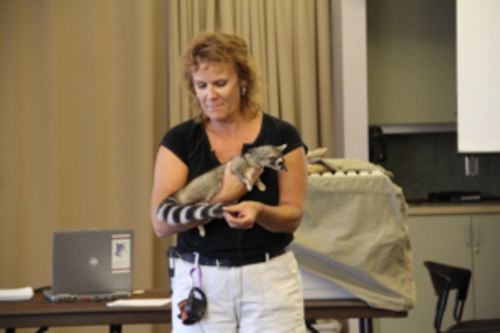
See what some Earth Clubs are doing:
- Alice Vail Middle School, Tucson
- Anza Trail School, Sahuarita
- Billy Lane Lauffer Middle School, Tucson
- Booth Fickett Middle School, Tucson
- Drachman Montessori School, Tucson
- Flowing Wells High School, Tucson
- Hendricks Elementary School, Tucson
- Highland Lakes Middle School, Deer Valley, AZ
- Mountainside Middle School, Scottsdale, AZ
- Nash Elementary, Tucson
- Salpointe Catholic High School, Tucson
- San Miguel High School, Tucson
- Utterback Middle School Earth Club
- Valencia Middle School, Tucson
Alice Vail Middle School, Tucson

Two Earth Camp teachers, Mollie Crouch and Debbie Hobbs coordinated with the Desert Museum to do a lab on Desert Adaptations at their school, as well as take their students on a field trip to the Museum. Students used the Museum's Digital Library to create Virtual Field Notebooks on the adaptations of Sonoran Desert plants and animals. They also implemented ecology activities related to native and non-native fish as well as invasive plants from the Discover a Watershed book from Arizona Project WET. Outside of the classroom, Alice Vail students adopted a nearby Eco-Park and helped to build rock-lined pathways, erosion control drainages, and maintained the park by picking up trash and trimming vegetation.
Mollie and Debbie shared some of the impact on their students:
Students gained a better appreciation and respect for the Desert ecosystem. We started the year with each student researching a different animal or plant in the Sonoran Desert. They had to know all about its habitat, interactions with its environment, and its special adaptations. They really got into their roles — one boy in particular who had researched the Harris Hawk. Every time we talked about the desert, he could quote something about the Harris Hawk and its relation to the desert ecosystem. When the guest speaker came to teach about adaptations, the group was able to correctly answer the questions and identify how the plants and animals survived. But the one boy just pestered the speaker, asking if she had brought the hawk since he knew so much about it. Sure enough, she brought out the hawk and we nearly had to contain him from jumping out of his seat with excitement. He was able to see "up-close and personal" all those details about his researched animal - that's what real connected learning looks like.
Before taking the students out to the Desert Museum, we had asked them how many had ever been there and it was less than 50%. Many of them were confused about the idea of going to a museum that was "outside." But on these trips, there were so many times we heard "I love this place" or "I can't wait to have my family come here" over and over by delighted students. Even the heat of being outside at a museum did not dampen their enthusiasm. It was a great opportunity to have taken students who rarely get the chance to go on this type of a trip.
Anza Trail School, Sahuarita
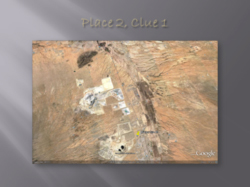
Earth Camp teacher, Mary Lamoreaux worked with her 6th and 7th grade advanced science classes to incorporate some of the remote sensing tools and field skills used in Earth Camp into her teaching. At the very start of the school year, students used Google Earth images to provide clues to their classmates in a guessing game about where they went on summer vacation. Later in the fall they participated in the Saguaro National Park BioBlitz, 24-hour effort to inventory as many species as possible in the Park.
Later in the school year, they did the following activities:
- School Water Audit
- Home Water Audit
- Used remote sensing to study changes due to natural hazards
- Learned about desert adaptations with live animals from the Desert Museum
- Learned about and sampled native desert foods
Billy Lane Lauffer Middle School, Tucson
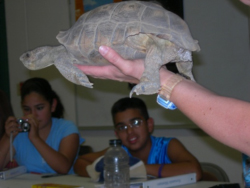
The Earth Club at Billy Lane Lauffer Middle School was started by an eighth grade student after attending Earth Camp. They had guest presentations from the Desert Museum and arranged a field trip, including parents and siblings to join. They participated in a number of activities from Arizona Project WET, learning about water resources and conservation. They also set up recycling bins at their school and helped with the school garden. They did an experiment with packaging and watched the movie "The Story of Stuff" which ridicules our "throw-away" society. The student writes: "To me it was a great opportunity for the school to be greener, and think greener."
Booth Fickett Middle School, Tucson
Garrett Pierce, Earth Camp Teacher, coordinated a Star Party with the Planetary Science Institute, as well as desert ecology outreach programs with the Desert Museum.
Drachman Montessori School, Tucson
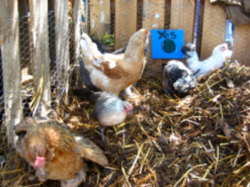
Earth Camp teacher, Wes Oswald, writes:
At our school, I implemented a successful school-wide recycling program this year. I also started a school-wide cafeteria composting program. This has been very successful, and I've got kids who actually argue over who gets to turn the compost! We teamed up with the Community Food Bank who built us a chicken coop, which has been fun and educational for our students. The Food Bank also granted us an aquaponics system which has been a great way for kids to learn about life cycles, chemistry, and ecosystems. We have done numerous native plant installs too to beautify our school and provide habitat for native insects and birds.
We also participated in the following presentations and events:
- Northern Jaguar Project presentation
- Field Trip to Pio Decimo Community Garden
- Global Youth Service Day 2012: Native plant install with Americorps volunteers
- 3 Day Camping trip to Cooper Center for Environmental Learning (Camp Cooper)
- Desert Museum Reptile Program
- BioBlitz at Saguaro National Park
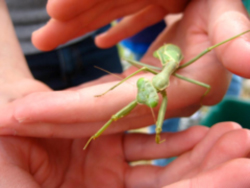
One success story was from our trip to Camp Cooper. It was great taking kids out camping and hiking who had never done so before. One of my students, Zia, while we were out on a hike told me, "I am always asking my dad to take me out hiking in the Tucson Mountains, but he is always too busy. It is so beautiful here I can't believe it."
Another success was implementing our school's compost system. Fortunately, fellow teachers and students were patient enough the first few weeks of composting when the smell of our pile was absoultely rank. But, sure enough, the bacteria set in, started working, and now our compost doesn't smell at all, and we compost about 5 gallons of cafeteria waste per day!
To learn more about ecology at Drachman, see their Facebook page at http://www.facebook.com/pages/Ecology-at-Drachman-Montessori-Elementary/159432864137895
(Photos from Ecology at Drachman Facebook page.)
Flowing Wells High School, Tucson

During 2011-13, Earth Camp teacher, William Golden worked with his high school Earth Club students on several environment-related projects.
- They designed and tested grey-water filters using sand, gravel and carbon.
- They participated in the Saguaro National Park Bioblitz, hiking to a remote site at which they spent three nights documenting species of plants and animals. To prepare for this, they used satellite imagery to look at the history of the site, including recent fires, and observe the availability of water in different parts of the park. The students were able to work with University and National Park Service biologists, herpetologists, ornithologists and others in this historic survey. They also took 25 students to the Greyhawk Nature Preserve on the San Pedro River where they measured water quality and observed a variety of wildlife at this site of successful riparian restoration and beaver reintroduction.
- They organized a Star Party for their school community, along with presentations on light pollution.
- They organized a fundraiser for their club.
- They collaborated with Zoo Club to build enrichment items for Desert Museum animals and received presentation on desert wildlife.
Hendricks Elementary School, Tucson, AZ
The Hendricks Elementary School Earth Club met 12 times, on Monday after school, during the 2012-2013 school year. There were 10 students enrolled in Earth Club, eight 4th grade girls, one 3rd grade boy & one 5th grade boy.Most of the activities we did had to do with our outdoor garden classroom. We planted and observed plant growth; ate edible plants; collected and planted seeds; made and painted garden benches; observed garden mammals, birds, reptiles and insects. We also learned about rainforest frogs and bromeliads and made models of bromeliads. The kids really enjoyed learning more about where there food comes from and how to grow their own food. Some have started gardens at their homes. We have continued to improve the garden and to compost. We will make at least one big change this year. We will be setting up the garden to catch runoff from the basketball court in order to help water the garden and save on using city water. I also will be writing grants to expand and improve the garden.
Highland Lakes Middle School, Deer Valley, AZ

Earth Camp teacher, Lindsey Stegh, involved all of her 167 students in a school water audit, replaced the aerators on 20 faucets in the school and reported the water savings to the administration. She then worked with several students who wanted to do more, looking at life in and around a local pond, and making water-conservation videos to show to others.
Mountainside Middle School, Scottsdale, AZ
Tracey Dodrill and Charlynne Herman, Earth Camp teachers, implemented numerous activities both in and out of class for their middle schoolers. They did a school-wide water audit, and a recycling poster project. They also took students to local STEM events, such as the Society of Women Engineers Arizona State University's Earth and Space Exploration Days, and the McDowell Sonoran Conservancy.
Nash Elementary, Tucson, AZ
Teachers, Shari Lossou-Lossavi and Diane Martinez met with their students the 1st and 3rd Wednesday of each month, with the exception of gardening days which required more time/meetings (we rotated the students for this). Our activities included:
- Starting a school garden
- working with Project Wet to do a school water audit
- attending the Water Festival
- numerous astronomy activities with resources from Planetary Science Institute
- visit to our classroom from Arizona Sonora Desert Museum, Dec. 11,2012
- visit to the Arizona Sonora Desert Museum for the Threatened and Endangered Species class and self-guided tour of the Museum, April 11, 2013
Mrs. Lossou-Lossavi and Mrs. Martinez also did a presentation about our school gardening experience at the University of Arizona's Nutrition Conference, July, 2013
Salpointe Catholic High School, Tucson

The Club at Salpointe was very active. They took several field trips, hosted a star party and animal outreach program, and accomplished the following changes at their school:
- Installed solar panels
- Placed more recycling bins around campus
- Weekly recycling bin emptying
- Encouraged use of reusable water bottles
- Moving towards paperless homework submission through turnitin.com and net classroom
- Campus light audit
San Miguel High School, Tucson

The Earth Club at San Miguel was started by Earth Camp students as well. They approached their AP Art teacher, and she agreed to bring conservation and art together by inviting staff and animals from the Desert Museum into their class. The teacher writes:
I think a personal story to share would be the joy it is to have an expert come into a room of teenagers and share with them live animals and watch these students return to children. Their eyes are wide and they become little sponges again, just soaking up everything Amy has to say. It engages all their senses and they seem to be awakened. Immediately you see the students who to touches even more as they talk about their desire to pursue a career in conservation.
Utterback Middle School Earth Club
The Utterback Earth Club was an official club at the middle school. The club had a President, Vice President, and a Secretary. We met approximately 8 times during the year. We had 2 visits from The Arizona- Sonora Desert Museum using live animals from the Sonoran Desert Bio region and one visit from Tucson Project WET in which we investigated the Colorado River Watershed. We using 2 meetings to plan and implement a challenging hike up Wasson Peak in the Tucson Mountains with students and families. The hike took place on a Saturday. After the hike we created a bulletin board in the school using the photographs from the hike. Attendance at the meetings ranged from a high of about 25 students to a low of about 15, on the hike we had about 15 students with 6 family members and 3 adult supervisors. We had terrific support from the all the sponsors! The population at our school is low socioeconomic status (Title 1) and with that often comes limited exposure to outdoor recreation activities. In many ways the primary responsibility of the Earth Club is expose students to the biodiversity in our area, to concepts and to vocabulary with which they are not familiar.
Valencia Middle School, Tucson
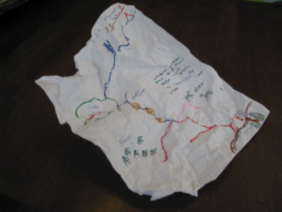
At Valencia Middle School, Earth Camp Teacher, Paul Garde implemented a 3-week unit on the Colorado River using the Discover a Watershed book from Arizona Project WET. His students also participated in three live-animal desert ecology programs from the Desert Museum.
